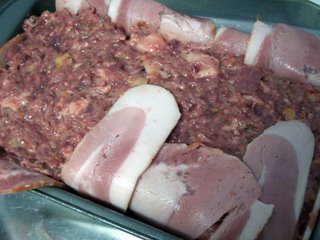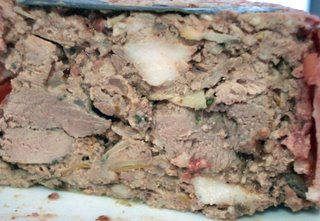Emergency Terrine
Pork, Duck and Cognac Terrine de Campagne
Crisis. Lunch for six people. MN needed something to serve for entrée. No time. Ahhh! Panic.
The benefits of having a foodblogger and culinary obsessive in the family are not extensively documented. Sometimes the down side is more prominent – that you are unlikely to ever have a hot meal in a restaurant again because your dining companion has to photograph it before it’s touched. But here is a definite plus: because I’m a nice person and on leave at the moment, I offered to make her a terrine for her lunch party. Terrines suit light eaters and ravenous hordes alike. You can prepare them in advance and they travel well, making them ideal for picnics or ferrying over to friends and relatives. Some people are scarred of pâtés and terrines, but if you can make a meatloaf, you can make a terrine. It’s just slightly more fiddly, but not much.

300 g pork mince
300 g chicken livers, trimmed
100 g pork belly chopped into small dice
6 rashers of bacon, or equivalent of pancetta
4 French (golden) shallots
2 cloves garlic
½ cup toasted slivered almonds or chopped pistachios
2 duck breast fillets, skin removed and fat rendered
Spices and flavourings: Juniper berries, nutmeg or mace, fresh thyme leaves, pepper, cognac or port, bay leaves.
Slice the duck breasts lengthways and marinade in a few tablespoons each of cognac and thyme, a few teaspoons of crushed juniper berries, and a decent grind of pepper and nutmeg. Leave for a few hours or overnight. Fry the shallots and garlic in the
 rendered duck fat and cool – don’t drain, the duck fat gives more flavour. Combine the pork belly, pork mince, shallots and garlic, a few tablespoons each of cognac and thyme, a few teaspoons of crushed juniper berries, and a decent grind of pepper and nutmeg. Leave to sit for 30 minutes or so and pour in the excess marinade from the duck. Pulse the chicken livers in a food processor ‘til they form a fairly smooth paste and mix this thoroughly with the pork mince mixture, adding in the nuts as well.
rendered duck fat and cool – don’t drain, the duck fat gives more flavour. Combine the pork belly, pork mince, shallots and garlic, a few tablespoons each of cognac and thyme, a few teaspoons of crushed juniper berries, and a decent grind of pepper and nutmeg. Leave to sit for 30 minutes or so and pour in the excess marinade from the duck. Pulse the chicken livers in a food processor ‘til they form a fairly smooth paste and mix this thoroughly with the pork mince mixture, adding in the nuts as well.Place a few fresh bay leaves attractively in the bottom on your terrine mould (I don’t have one so I use a non-stick loaf tin) then line it with bacon, making sure you leave an overlap to wrap over the top. Pour in half the pork mince mixture, then lay the strips of duck breast over the top to form a layer. Pour in the rest of the mixture then fold the overlapped bacon over the top. Cover the terrine with baking paper then foil and secure tightly round the edge. Place in a baking dish and pour boiling water half way up the sides, and bake at 170°C for 90 minutes. Towards the end of cooking, check that the terrine has shrunk away from the sides. There will be a luscious pool of juices surrounding the terrine.

Remove and let cool slightly (leave the foil covering in place) then weight the top of the terrine with heavy cans or wine bottles. It’s good to do this gradually (ie progressively heavier weights) so you don’t loose the juices and they re-absorb into the terrine and form a glossy aspic layer around the outside. Refrigerate the weighted terrine for at least 24 hours before unmoulding. To unmould, dip the terrine briefly into hot water and turn out onto the serving dish. Serve with crusty bread, some type of relish, cornichons etc.

Terrines develop more flavour as they age so make it a few days at least before you want to use it. I also make a smaller one to test out the flavour and texture and check what might go best with it (these are the pix of the inside texture I have here). Apparently the big one was a hit – finished unmoulded pic courtesy of MN & P.





0 Comments:
Post a Comment
<< Home